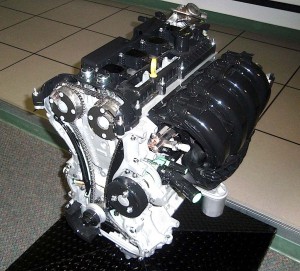The 2.0-liter four-cylinder engine has been a staple of automotive propulsion around the world for decades — in places like Asia and Europe and Australia and Africa, anyway, but not so much here in the States. Americans have tended to shy away from little 122 cubic-inch engines, but with gasoline at $3.50 and rising, that reluctance is wearing away.
Or so Ford hopes. With the introduction of the 2012 Ford Focus, there’s a new 2.0-liter four-cylinder engine that promises 160 horsepower, 147 foot-pounds of torque, and, in the specially equipped Focus SFE model, with a 6-speed automatic transmission, 28 miles per gallon in city driving and 40 miles per gallon on the highway (the 5-speed manual transmission gets a rating of 28 city, 36 highway).
Ford just showed TheDetroitBureau.com the guts of this new engine, designed for use in a range of small and smaller Ford products well into the future. The maker is betting that powerplants like the new 2.0 I4 could provide a viable alternative for more costly hybrids and even the more sophisticated — but expensive — Ford EcoBoost for many customers.
The aluminum-intensive naturally aspirated engine uses a bore of 87.5 millimeters and a stroke of 83.1 millimeters. It employs a combination of proven technologies to make both its horsepower and fuel economy numbers, including direct gasoline injection into the cylinders, twin independent variable camshaft timing, which Ford calls Ti-VCT, a very high compression ratio of 12:1, and a raft of internal anti-friction measures to make 80 horsepower liter of displacement.
While most new engine designs with direct injection have the fuel injector centered in the combustion chamber next to the spark plug, the Ford engine uses a side-mounted fuel injector and a specially shaped piston crown to combust the fuel/air mixture most efficiently, using a stratified charge for cold starts that requires two shots per cycle from the high-pressure fuel injectors (old-style port injectors use about 60 psi of pressure, while the Denso-supplied fuel injection system is based on a very a 2200-2800 psi operating pressure). Each injector nozzle has six tiny holes in it, each aimed at a precise spot in the combustion chamber for best combustion.
Ford says the side-injection setup runs cooler than other systems and costs far less to implement.
Ford says the new Focus engine, built in Dearborn, Michigan, is designed for 87 octane regular fuel, but will readily accept E85 ethanol fuel, which has an even higher octane than gasoline, and will pass the nation’s toughest emissions regulations, California’s Partial Zero Emission Vehicle or PZEV level.
The high-performance Focus ST will use a 250-horspower turbocharged, direct-injected EcoBoost version of this engine when it joins the Focus product lineup later in the model year.


